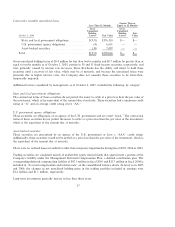Starbucks 2005 Annual Report Download - page 49
Download and view the complete annual report
Please find page 49 of the 2005 Starbucks annual report below. You can navigate through the pages in the report by either clicking on the pages listed below, or by using the keyword search tool below to find specific information within the annual report.Property, Plant and Equipment
Property, plant and equipment are carried at cost less accumulated depreciation. Depreciation of property,
plant and equipment, which includes assets under capital leases, is provided on the straight-line method over
estimated useful lives, generally ranging from two to seven years for equipment and 30 to 40 years for
buildings. Leasehold improvements are amortized over the shorter of their estimated useful lives or the related
lease life, generally 10 years. For leases with renewal periods at the Company's option, Starbucks generally
uses the original lease term, excluding renewal option periods to determine estimated useful lives. If failure to
exercise a renewal option imposes an economic penalty to Starbucks, management may determine at the
inception of the lease that renewal is reasonably assured and include the renewal option period in the
determination of appropriate estimated useful lives. The portion of depreciation expense related to production
and distribution facilities is included in ""Cost of sales including occupancy costs'' on the consolidated
statements of earnings. The costs of repairs and maintenance are expensed when incurred, while expenditures
for refurbishments and improvements that significantly add to the productive capacity or extend the useful life
of an asset are capitalized. When assets are retired or sold, the asset cost and related accumulated depreciation
are eliminated with any remaining gain or loss reflected in net earnings.
Goodwill and Other Intangible Assets
Goodwill and other intangible assets are tested for impairment annually in June and more frequently if facts
and circumstances indicate goodwill carrying values exceed estimated reporting unit fair values and if
indefinite useful lives are no longer appropriate for the Company's trademarks. Based on the impairment tests
performed, there was no impairment of goodwill in fiscal 2005, 2004 and 2003. Definite-lived intangibles,
which mainly consist of contract-based patents and copyrights, are amortized over their estimated useful lives.
For further information on goodwill and other intangible assets, see Note 9.
Long-lived Assets
When facts and circumstances indicate that the carrying values of long-lived assets may be impaired, an
evaluation of recoverability is performed by comparing the carrying values of the assets to projected future
cash flows in addition to other quantitative and qualitative analyses. Upon indication that the carrying values
of such assets may not be recoverable, the Company recognizes an impairment loss by a charge against current
operations. Property, plant and equipment assets are grouped at the lowest level for which there are
identifiable cash flows when assessing impairment. Cash flows for retail assets are identified at the individual
store level.
The Company recognized net impairment and disposition losses of $21.2 million, $18.8 million and
$15.9 million in fiscal 2005, 2004 and 2003, respectively, primarily from renovation and remodeling activity
and, to a lesser extent, from underperforming Company-operated retail stores, in the normal course of
business. Depending on the underlying asset that is impaired, these losses may be recorded in any one of the
operating expense lines on the consolidated statements of earnings: for retail operations, these losses are
recorded in ""Store operating expenses''; for Specialty Operations, these losses are recorded in ""Other
operating expenses''; and for all other operations, these losses are recorded in either ""Cost of sales including
occupancy costs'' or ""General and administrative expenses.''
Insurance Reserves
The Company uses a combination of insurance and self-insurance mechanisms, including a wholly owned
captive insurance entity and participation in a reinsurance pool, to provide for the potential liabilities for
workers' compensation, healthcare benefits, general liability, property insurance, director and officers' liability
insurance and vehicle liability. Liabilities associated with the risks that are retained by the Company are not
47
























